RS Aggarwal Solutions Class 10 Chapter 13 Constructions
These Solutions are part of RS Aggarwal Solutions Class 10. Here we have given RS Aggarwal Solutions Class 10 Chapter 13 Constructions
Exercise 13A
Question 1:
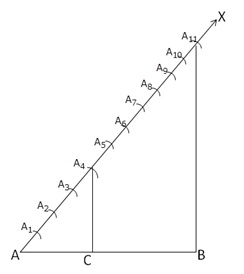
Steps of construction:
Step 1 : Draw a line segment AB = 6.5 cm
Step 2: Draw a ray AX making ∠ BAX.
Step 3: Along AX mark (4+7) = 11 points
A1, A2, A3, A4, A5, A6, A7, A8, A9, A10, A11, such that
AA1 = A1A2
Step 4: Join A11 and B.
Step 5: Through A4 draw a line parallel to A11 B meeting AB at C.
Therefore, C is the point on AB, which divides AB in the ratio 4 : 7
On measuring,
AC = 2.4 cm
CB = 4.1 cm
Read More:
- Construction of an Equilateral Triangle
- Construction Of Similar Triangle As Per Given Scale Factor
- Construction Of A Line Segment
- Construction Of The Bisector Of A Given Angle
- Construction Of Perpendicular Bisector Of A Line Segment
- Construction Of An Angle Using Compass And Ruler
Question 2:
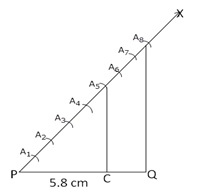
Steps of Construction:
Step 1 : Draw a line segment PQ = 5.8 cm
Step 2: Draw a ray PX making an acute angle QPX.
Step 3: Along PX mark (5 + 3) = 8 points
A1, A2, A3, A4, A5, A6, A7 and A8 such that
PA1 = A1A2 = A2A3 = A3A4 = A4A5 = A5A6 = A6A7 = A7A8
Step 4: Join A8Q.
Step 5: From A5 draw A5C || A8Q meeting PQ at C.
C is the point on PQ, which divides PQ in the ratio 5 : 3
On measurement,
PC = 3.6 cm, CQ = 2.2 cm
More Resources
Question 3:
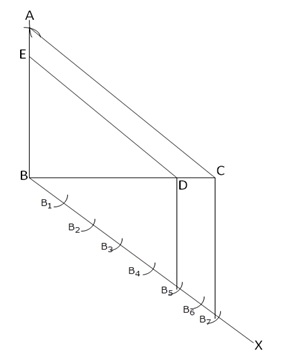
Steps of construction:
Step 1: Draw a line segment BC = 6 cm
Step 2: With B as centre and radius equal to 5 cm draw an arc.
Step 3: With C as centre and radius equal to 7 cm draw another arc cutting the previous arc at A.
Step 4: Join AB and AC. Thus, ∆ABC is obtained.
Step 5: Below BC draw another line BX.
Step 6: Mark 7 points B1B2B3B4B5B6B7 such that
BB1 = B1B2 = B2B3 = B3B4 = B4B5 = B5B6 = B6B7
Step 7: Join B7C.
Step 8: from B5, draw B5D || B7C.
Step 9: Draw a line DE through D parallel to CA.
Hence ∆ BDE is the required triangle.
Question 4:
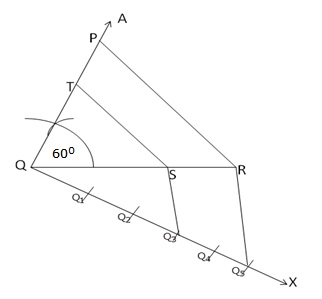
Steps of construction:
Step 1: Draw a line segment QR = 6 cm
Step 2: At Q, draw an angle RQA of 60◦.
Step 3: From QA cut off a segment QP = 5 cm.
Join PR. ∆PQR is the given triangle.
Step 4: Below QR draw another line QX.
Step 5: Along QX cut – off equal distances Q1Q2Q3Q4Q5
QQ1 = Q1Q2 = Q2Q3 = Q3Q4 = Q4Q5
Step 6: Join Q5R.
Step 7: Through Q3 draw Q3S || Q5R.
Step 8: Through S, draw ST || PR.
∆ TQS is the required triangle.
Question 5:
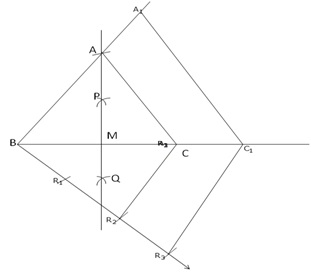
Steps of construction:
Step 1: Draw a line segment BC = 6 cm
Step 2: Draw a right bisector PQ of BC meeting it at M.
Step 3: From QP cut – off a distance MA = 4 cm
Step 4: Join AB, AC.
∆ ABC is the given triangle.
Step 5: Below BC, draw a line BX.
Step 6: Along BX, cut – off 3 equal distances such that
BR1 = R1R2 = R2R3
Step 7: Join R2C.
Step 8: Through R3 draw a line R3C1 || R2C.
Step 9 : Through C1 draw line C1A1 || CA .
∆ A1BC1 is the required triangle.
Question 6:
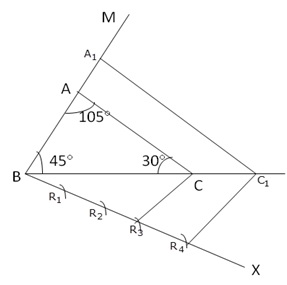
Steps of Construction:
Step 1: Draw a line segment BC = 5.4 cm
Step 2. At B, draw ∠ CBM = 45°
Step 3: Now ∠ A = 105°, ∠ B = 45°, ∠ C = 180° – (105°+ 45°) = 30°
At C draw ∠ BCA = 30°.
∆ ABC is the given triangle.
Step 4: Draw a line BX below BC.
Step 5: Cut-off equal distances such that BR1 = R1R2 = R2R3 = R3R4
Step 6: Join R3C.
Step 7: Through R4, draw a line R4C1 || R3C.
Step 8: Through C1 draw a line C1A1 parallel to CA.
∆ A1BC1 is the required triangle.
Question 7:
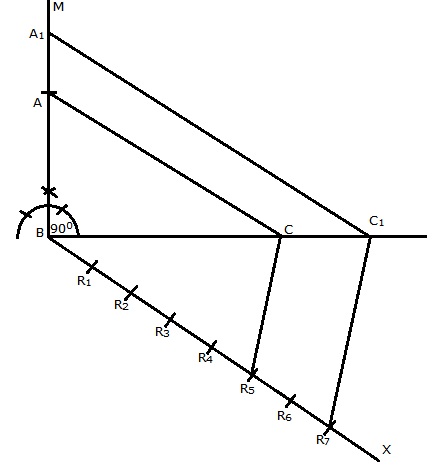
Steps of Construction:
Step 1: Draw a line segment BC = 4 cm
Step 2: Draw a right- angle CBM at B.
Step 3: Cut-off BA = 3cm from BM.
Step 4: Join AC.
ΔABC is the given triangle.
Step 5: Below BC draw a line BX.
Step 6: Along BX, cut-off 7 equal distances such that
BR1 = R1R2 = R2R3 = R3R4 = R4R5 = R5R6 = R6R7
Step 7: Join R5C.
Step 8: Through R7 draw a line parallel to R5C cutting BC produced at C1
Step 9: Through C1 draw a line parallel to CA cutting BA at A1
∆ A1BC1 is the required triangle.
Question 8:
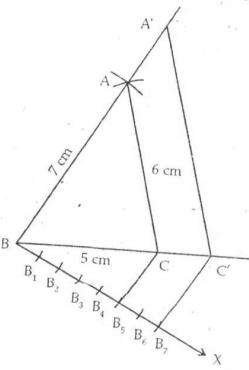
Steps of Construction:
Step 1: draw a line segment BC = 5 cm
Step 2: With B as centre and radius 7cm an arc is drawn.
Step 3: With C as centre and radius 6 cm another arc is drawn intersecting the previous arc at A.
Step 4: Join AB and AC.
Step 5: ∆ ABC is the given triangle.
Step 6: Draw a line BX below BC.
Step 7: Cut- off equal distances from DX such that
BB1 = B1B2 = B2B3 = B3B4 = B4B5 = B5B6 = B6B7
Step 8: join B5C.
Step 9: Draw a line through B7 parallel to B5C cutting BC produced at C’.
Step 10: Through C’ draw a line parallel to CA, cutting BA produced at A’.
Step 11: ∆ A’BC’ is the required triangle.
Question 9:
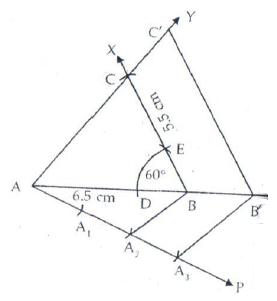
Steps of construction:
Step 1: Draw a line segment AB = 6.5 cm
Step 2: With B as centre and some radius draw an arc cutting AB at D.
Step 3: With centre D and same radius draw another arc cutting previous arc at E. ∠ ABE = 60°
Step 4: Join BE and produce it to a point X.
Step 5: With centre B and radius 5.5 cm draw an arc intersecting BX at C.
Step 6: Join AC.
∆ ABC is the required triangle.
Step 7: Draw a line AP below AB.
Step 8: Cut- off 3 equal distances such that
AA1 = A1A2 = A2A3
Step 9: Join BA2
Step 10: Draw A3B’ through A3 parallel to A3B.
Step 11: Draw a line parallel to BC through B’ intersecting AY at C’.
∆ AB’C’ is the required triangle.
Question 10:
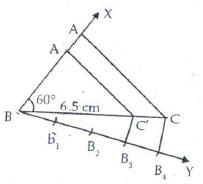
Steps of construction:
Step 1: Draw a line segment BC = 6.5 cm
Step 2: Draw an angle of 60° at B so that ∠ XBC = 60°.
Step 3: With centre B and radius 4.5cm, draw an arc intersecting XB at A.
Step 4: Join AC.
∆ ABC is the required triangle.
Step 5: Draw a line BY below BC.
Step 6: Cut- off 4 equal distances from BY.
Such that BB1 = B1B2 = B2B3 = B3B4
Step 7: Join CB4
Step 8: draw B3C’ parallel to CB4
Step 9: Draw C’A’ parallel to CA through C’ intersecting BA produced at A’.
∆ A’BC’ is the required similar triangle.
Question 11:
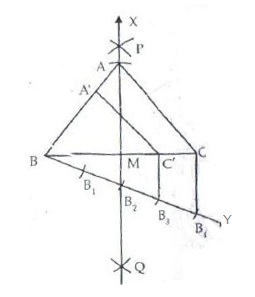
Steps of Construction:
Step 1: Draw a line segment BC = 9 cm
Step 2: with centre B and radius more than 1/2 BC, draw arcs on both sides of BC.
Step 3: With centre C and same radius draw other arcs on both sides of BC intersecting previous arcs at P and Q.
Step 4: join PQ and produce it to a point X. PQ meets BC at M.
Step 5: With centre M and radius 5 cm, draw an arc intersecting MX at A.
Step 6: Join AB and AC.
∆ ABC is the required triangle.
Step 7: Draw a line BY below BC.
Step 8: Cut off 4 equal distances from BY so that
BB1 = B1B2 = B2B3 = B3B4
Step 9: Join CB4
Step 10: Draw C’B3 parallel to CB4
Step 11: Draw C’A’ parallel to CA, through C’ intersecting BA at A’.
∆ A’BC’ is the required similar triangle.
Exercise 13B
Question 1:

Steps of construction:
Step 1: Draw a circle of radius 5 cm with centre O.
Step 2: A point P at a distance of 8cm from O is taken.
Step 3: A right bisector of OP meeting OP at M is drawn.
Step 4: With centre M radius OM a circle is drawn intersecting the previous circle at T1 and T2
Step 5: Join PT1 and PT2
PT1 and PT2 and the required tangents. Measuring PT1 and PT2
We find, PT1= PT2 =6.2 cm
Question 2:
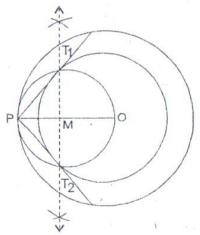
Steps of construction:
Step 1: Two concentric circles with centre O and radii 4 cm and 6 cm are drawn.
Step 2: A point P is taken on outer circle and O, P are joined.
Step 3: A right bisector of OP is drawn bisecting OP at M.
Step 4: With centre M and radius OM a circle is drawn cutting the inner circle at T1 and T2
Step 5: Join PT1 and PT2
PT1 and PT2 are the required tangents. Further PT1= PT2 =4.8 cm
Question 3:
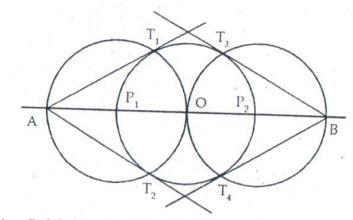
Steps of construction:
Step 1: Draw a circle with centre O and radius 3.5 cm
Step 2: the diameter P1P2 is extended to the points A and B such that AO = OB = 7 cm
Step 3: With centre P1 and radius 3.5 cm draw a circle cutting the first circle at T1 and T2
Step 4: join AT1 and AT2
Step 5: With centre P2 and radius 3.5 cm draw another circle cutting the first circle at T3 and T4
Step 6: Join BT3 and BT4 . Thus AT1, AT2 and BT3, BT4 are the required tangents to the given circle from A and B.
Question 4:

Steps of construction:
(i) A circle of radius 4.2 cm at centre O is drawn.
(ii) A diameter AB is drawn.
(iii) With OB as base, an angle BOC of 45° is drawn.
(iv) At A, a line perpendicular to OA is drawn.
(v) At C, a line perpendicular to OC is drawn.
(vi) These lines intersect each other at P.
PA and PC are the required tangents.
Question 5:
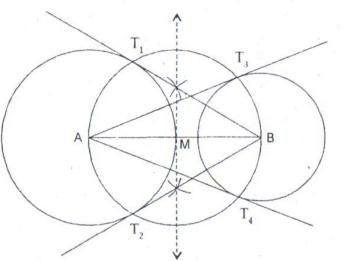
Steps of construction:
(i) A line segment AB = 8,5 cm is drawn.
(ii) Draw a right bisector of AB which meets AB at M.
(iii) With M as centre AM as radius a circle is drawn intersecting the given circles at T1, T2, T3 and T4
(iv) Join AT3, AT4 and BT1, BT2.
Thus AT3, AT4, BT1, BT2 are the required tangents.
Question 6:
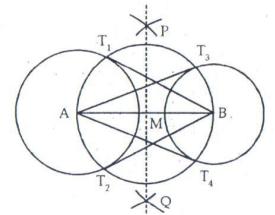
Steps of construction:
(i) Draw a line segment AB = 7cm
(ii) Taking A as centre and radius 3 cm, a circle is drawn.
(iii) With centre B and radius 2.5 cm, another circle is drawn.
(iv) With centre A and radius more than 1/2 AB, arcs are drawn on both sides of AB.
(v) With centre B and the same radius, [as in step (iv)] arcs are drawn on both sides of AB intersecting previous arcs at P and Q.
(vi) Join PQ which meets AB at M.
(vii) With centre M and radius AM, a circle is drawn which intersects circle with centre A at T1 and T2 and the circle with centre B at T3 and T4
(viii) Join AT3, AT4, BT1 and BT2
Thus, AT3, AT4, BT1, BT2 are the required tangents.
Question 7:
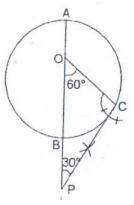
Steps of construction:
(i) A circle of radius 3 cm with centre O is drawn.
(ii) A radius OC is drawn making an angle of 60° with the diameter AB.
(iii) At C, ∠OCP = 90° is drawn.
CP is required tangent.
Question 8:
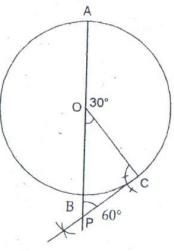
Steps of construction :
(i) Draw a circle of radius 4 cm with centre O.
(ii) With diameter AB, a line OC is drawn making an angle of 30° i.e., ∠BOC = 30°
(iii) At C a perpendicular to OC is drawn meeting OB at P.
PC is the required tangent.
Hope given RS Aggarwal Solutions Class 10 Chapter 13 Constructions are helpful to complete your math homework.
If you have any doubts, please comment below. A Plus Topper try to provide online math tutoring for you.